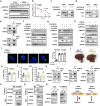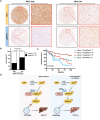MLKL promotes hepatocarcinogenesis through inhibition of AMPK-mediated autophagy
- PMID: 38783090
- PMCID: PMC11303813
- DOI: 10.1038/s41418-024-01314-5
MLKL promotes hepatocarcinogenesis through inhibition of AMPK-mediated autophagy
Abstract
The pseudokinase mixed lineage kinase domain-like (MLKL) is an essential component of the activation of the necroptotic pathway. Emerging evidence suggests that MLKL plays a key role in liver disease. However, how MLKL contributes to hepatocarcinogenesis has not been fully elucidated. Herein, we report that MLKL is upregulated in a diethylnitrosamine (DEN)-induced murine HCC model and is associated with human hepatocellular carcinomas. Hepatocyte-specific MLKL knockout suppresses the progression of hepatocarcinogenesis. Conversely, MLKL overexpression aggravates the initiation and progression of DEN-induced HCC. Mechanistic study reveals that deletion of MLKL significantly increases the activation of autophagy, thereby protecting against hepatocarcinogenesis. MLKL directly interacts with AMPKα1 and inhibits its activity independent of its necroptotic function. Mechanistically, MLKL serves as a bridging molecule between AMPKα1 and protein phosphatase 1B (PPM1B), thus enhancing the dephosphorylation of AMPKα1. Consistently, MLKL expression correlates negatively with AMPKα1 phosphorylation in HCC patients. Taken together, our findings highlight MLKL as a novel AMPK gatekeeper that plays key roles in inhibiting autophagy and driving hepatocarcinogenesis, suggesting that the MLKL-AMPKα1 axis is a potential therapeutic target for HCC.
© 2024. The Author(s), under exclusive licence to ADMC Associazione Differenziamento e Morte Cellulare.
Conflict of interest statement
The authors declare no competing interests.
Figures








Similar articles
-
Oroxyloside inhibits liver fibrosis and hepatocarcinogenesis dependent on hepatocyte-specific knockout of Atg5.Phytomedicine. 2025 Sep;145:157053. doi: 10.1016/j.phymed.2025.157053. Epub 2025 Jul 6. Phytomedicine. 2025. PMID: 40663935
-
MLKL-USP7-UBA52 signaling is indispensable for autophagy in brain through maintaining ubiquitin homeostasis.Autophagy. 2025 Feb;21(2):424-446. doi: 10.1080/15548627.2024.2395727. Epub 2024 Sep 19. Autophagy. 2025. PMID: 39193909 Free PMC article.
-
Carbohydrate-Responsive Element-Binding Protein-Associated Metabolic Changes in Chemically Induced Hepatocarcinogenesis Mouse Model.Int J Mol Sci. 2025 Jul 18;26(14):6932. doi: 10.3390/ijms26146932. Int J Mol Sci. 2025. PMID: 40725179 Free PMC article.
-
Nonalcoholic fatty liver disease and hepatocellular carcinoma.Metabolism. 2016 Aug;65(8):1151-60. doi: 10.1016/j.metabol.2016.01.010. Epub 2016 Jan 23. Metabolism. 2016. PMID: 26907206
-
The Protective Role of miR-125b in Hepatocellular Carcinoma: Unraveling Tumor-Suppressive Mechanisms.Curr Mol Med. 2025;25(6):663-671. doi: 10.2174/0115665240304247240529074123. Curr Mol Med. 2025. PMID: 38859784 Review.
Cited by
-
New Insights into AMPK, as a Potential Therapeutic Target in Metabolic Dysfunction-Associated Steatotic Liver Disease and Hepatic Fibrosis.Biomol Ther (Seoul). 2025 Jan 1;33(1):18-38. doi: 10.4062/biomolther.2024.188. Epub 2024 Dec 20. Biomol Ther (Seoul). 2025. PMID: 39702310 Free PMC article. Review.
-
Autophagy: Shedding Light on the Mechanisms and Multifaceted Roles in Cancers.Biomolecules. 2025 Jun 22;15(7):915. doi: 10.3390/biom15070915. Biomolecules. 2025. PMID: 40723786 Free PMC article. Review.
-
Mixed lineage kinase domain-like protein deficiency exacerbates early injury in a mouse model of acetaminophen hepatotoxicity.Toxicol Sci. 2025 May 1;205(1):220-232. doi: 10.1093/toxsci/kfaf022. Toxicol Sci. 2025. PMID: 39985503
-
Mixed lineage kinase domain-like protein in liver diseases: Cell-type-specific functions and dual roles.World J Gastroenterol. 2025 Apr 14;31(14):104523. doi: 10.3748/wjg.v31.i14.104523. World J Gastroenterol. 2025. PMID: 40248377 Free PMC article.
-
AMPK: The energy sensor at the crossroads of aging and cancer.Semin Cancer Biol. 2024 Nov;106-107:15-27. doi: 10.1016/j.semcancer.2024.08.002. Epub 2024 Aug 26. Semin Cancer Biol. 2024. PMID: 39197808 Review.
References
MeSH terms
Substances
LinkOut - more resources
Full Text Sources
Medical
Molecular Biology Databases
Miscellaneous

